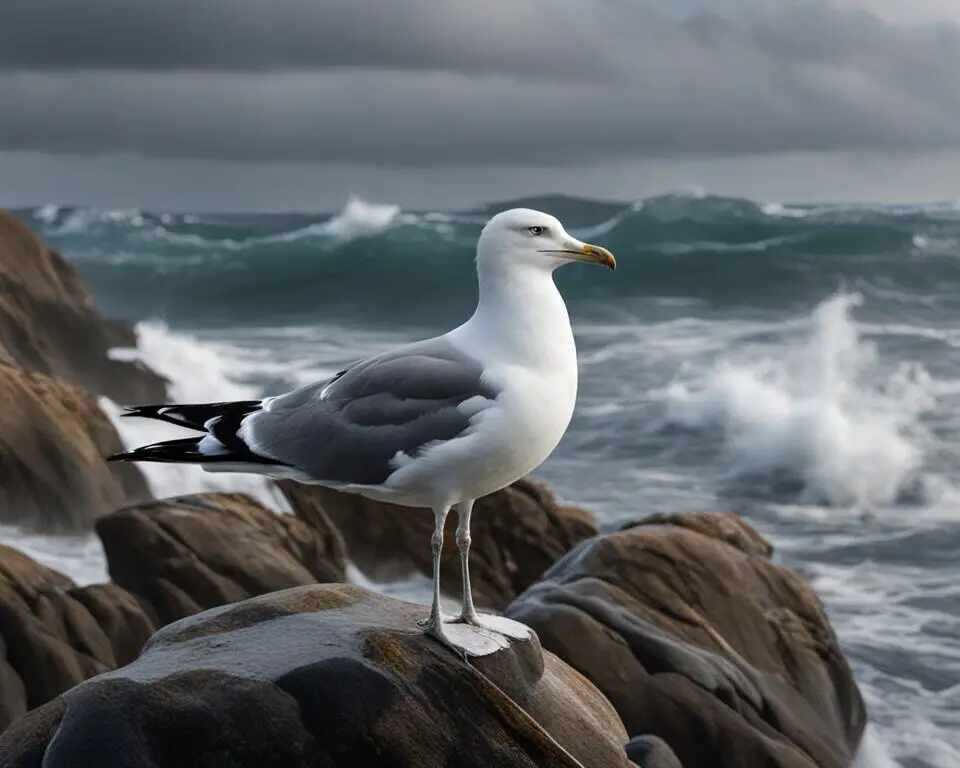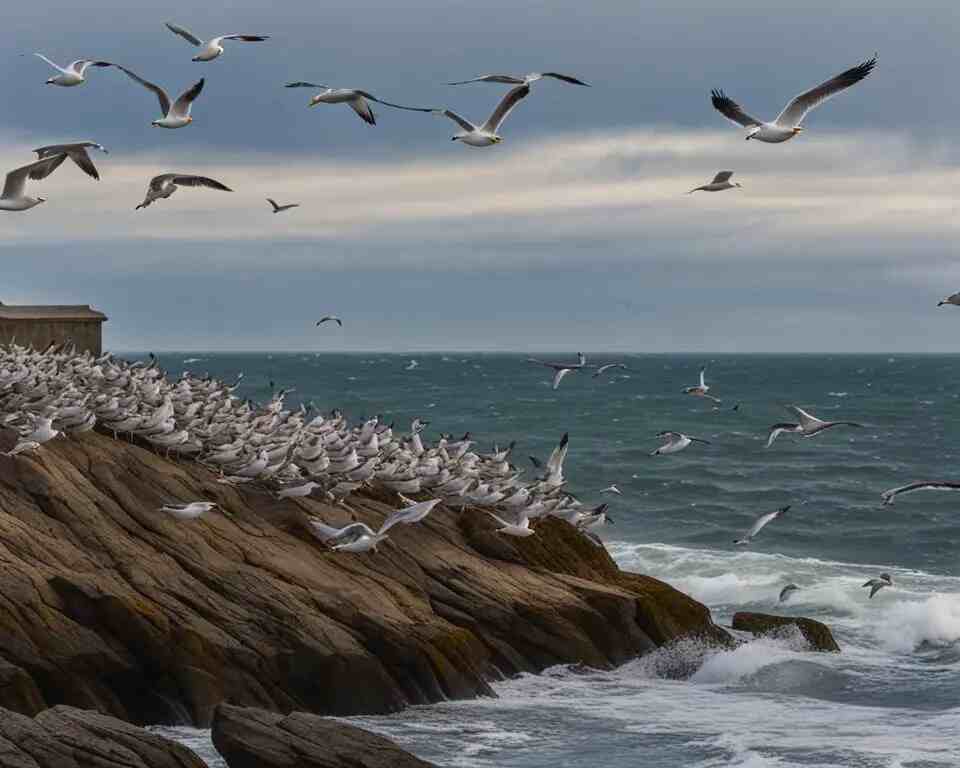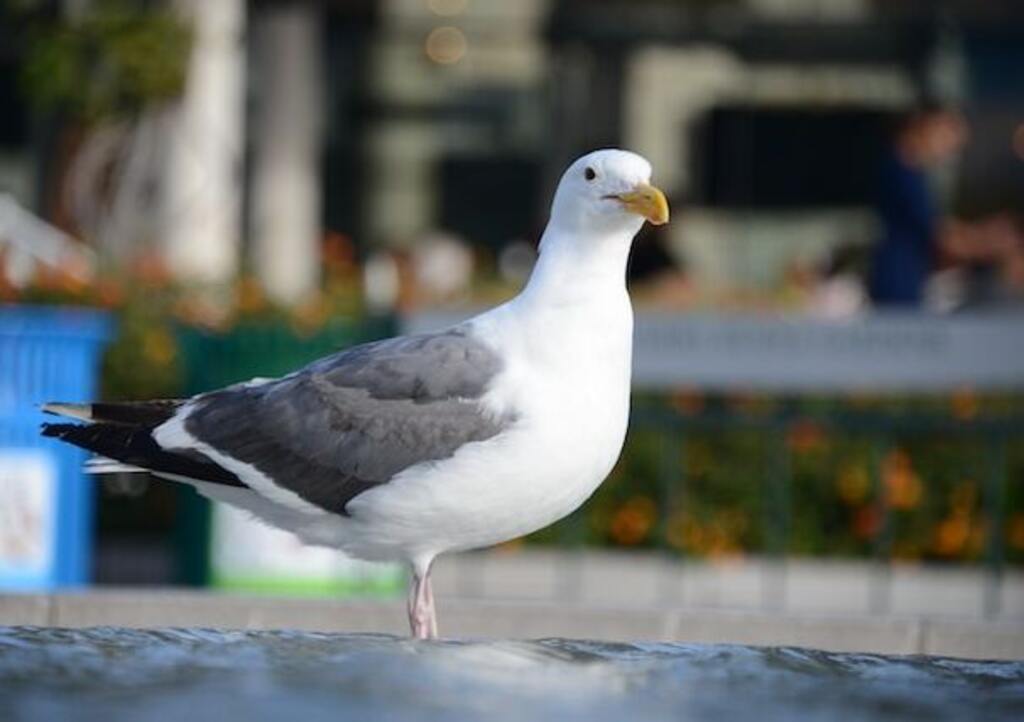Seagulls, also known as gulls, are fascinating creatures found in various habitats around the world. They are highly intelligent and often misunderstood. Have you ever wondered how long do seagulls live for?
In this article, I will delve into the lifespan of seagulls, exploring their average life expectancy, factors influencing their longevity, and the aging process they go through. Let’s uncover the secrets of these resilient birds.
Table of Contents
- 1 Key Takeaways:
- 2 Factors Influencing Seagull Lifespan
- 3 Seagull Aging Process
- 4 Seagull Mortality Rate
- 5 The Life Cycle of a Seagull
- 6 Seagull Predators and Protection
- 7 Human Impact and Seagull Lifespan
- 8 How Seagulls Survive in Different Environments
- 9 Conclusion
- 10 FAQs
- 10.1 How long do seagulls typically live?
- 10.2 What factors can influence the lifespan of seagulls?
- 10.3 At what age do seagulls reach sexual maturity?
- 10.4 What is the survival rate of adult seagulls?
- 10.5 Do seagulls have natural predators?
- 10.6 How do seagulls protect themselves from predators?
- 10.7 How does human activity impact the lifespan of seagulls?
- 10.8 How do seagulls survive in different environments?
- 11 Source Links
- 12 Author
Key Takeaways:
- Seagulls have an average lifespan of 8 to 20 years, with some individuals living up to 30 years or more.
- Factors such as food availability, habitat quality, predation, and human impact can influence seagull lifespans.
- Seagulls reach sexual maturity between the ages of 2 and 4 years and have slow lifecycles.
- Once seagulls reach adulthood, they have a high survival rate, but baby seagulls are more vulnerable to predation.
- Seagulls are adaptable birds and can survive in various environments, using different strategies to ensure their longevity.

Factors Influencing Seagull Lifespan
Several factors can influence the lifespan of seagulls. These factors play a crucial role in shaping the variations in seagull lifespans. It is important to understand these factors to gain insights into the dynamics of seagull populations and their overall health and well-being.
One of the primary factors affecting seagull lifespan is the availability of food. Seagulls that have access to abundant food sources are more likely to have longer lifespans. A diverse and plentiful diet ensures that seagulls receive the necessary nutrition and energy for their survival and reproductive success.
On the other hand, seagulls facing food scarcity may experience shorter lifespans due to malnutrition and weakened immune systems.
Habitat quality is another significant factor that can influence seagull lifespan. Seagulls thrive in habitats that provide suitable nesting sites, ample food resources, and protection from predators. Destruction or degradation of their habitats can lead to increased stress, reduced reproductive success, and higher mortality rates.
Additionally, seagulls exposed to polluted environments may suffer from health issues that ultimately impact their lifespan.
Predation and exposure to diseases are additional factors that can affect seagull lifespan. Seagulls that are constantly under threat from predators may have shorter lifespans. Predators such as foxes, raccoons, and cats can pose a significant risk to both adult seagulls and their offspring.
Furthermore, seagulls may be susceptible to various bacterial, viral, and parasitic infections, which can compromise their health and survival.
Understanding these factors and their complex interactions is essential for effectively managing seagull populations and promoting their long-term survival.
Conservation efforts aimed at preserving seagull habitats, ensuring access to sufficient food sources, and minimizing anthropogenic impacts can contribute to the well-being and longevity of these remarkable birds.
| Factors Influencing Seagull Lifespan | Description |
|---|---|
| Availability of Food | Seagulls with access to abundant food sources are more likely to have longer lifespans. |
| Habitat Quality | Seagulls thrive in habitats that provide suitable nesting sites, ample food resources, and protection from predators. |
| Predation | Constant threat from predators such as foxes, raccoons, and cats can impact seagull lifespan. |
| Exposure to Diseases | Seagulls may be susceptible to various bacterial, viral, and parasitic infections that can compromise their health and survival. |
Seagull Aging Process
As seagulls age, their body functions may decline, and they may become more susceptible to diseases and other age-related issues. The aging process of seagulls can vary depending on individual factors such as genetics and environmental conditions.
One of the key factors influencing the aging process of seagulls is their ability to adapt to changing environments. Seagulls that live in polluted areas or habitats facing destruction may experience accelerated aging due to the negative impacts on their health.
On the other hand, seagulls living in clean and pristine environments may have a slower aging process and therefore, a longer lifespan.
Research has shown that seagulls with higher levels of oxidative stress, caused by factors such as exposure to pollutants and poor diet, tend to have shorter lifespans. Conversely, seagulls that have access to nutritious food sources and live in clean environments have been found to age more gradually and live longer lives.
The Role of Genetics in Seagull Aging
Genetics also play a significant role in the aging process of seagulls. Just like humans, some seagulls may inherit genes that make them more susceptible to age-related diseases and decline. On the other hand, certain genetic variations may confer a higher resistance to diseases and better overall health, leading to a longer lifespan.
In conclusion, the aging process of seagulls is influenced by both environmental and genetic factors. While individual seagulls may age differently, their ability to adapt to changing environments and genetic predispositions are key determinants of their overall lifespan.

Seagull Mortality Rate
When it comes to seagull survival, adult seagulls have a relatively high survival rate. These resilient birds have a year-on-year survival rate of around 90% once they reach adulthood. [1] However, their mortality is primarily due to natural causes such as fatigue and exhaustion rather than predation.
[1] It is their vulnerability as young chicks that poses a greater risk, with lower survival rates compared to adults. Baby seagulls face threats from predators such as foxes, raccoons, and cats, which can significantly impact their survival rate. [1]
Moreover, seagulls are not exempt from the risk of infections and diseases. Bacterial, viral, and parasitic infections can affect their overall health and contribute to their mortality rate. [1] These factors, along with the challenges faced during their early stages of life, result in varying mortality rates within seagull populations.
To gain a better understanding of the seagull mortality rate and its impact on their populations, researchers monitor and study the causes of death in seagulls. By identifying these factors, conservation efforts can be directed towards mitigating risks and protecting seagull populations.
“Seagulls are fascinating creatures that display remarkable adaptability. While their survival rate is relatively high once they reach adulthood, their vulnerability as chicks and the presence of diseases highlight the importance of protecting their habitats and populations.” – Seagull Researcher
Seagull Predators and Their Impact on Lifespan
The mortality rate of seagulls is influenced by various predators in their ecosystem. As adults, seagulls have developed strong defenses against potential threats, including predators like eagles, skewers, and giant petrels. [2] Their alertness and intelligence contribute to their ability to fend off these predators effectively.
[2] However, baby seagulls face a more significant risk as they lack the physical strength and experience of their adult counterparts, making them vulnerable to predation. [1] Seagulls protect themselves by forming large flocks and utilizing defensive behaviors when confronted by potential threats. [1]
Seagulls also choose nesting sites strategically to minimize the risk of predation. They often opt for locations that are difficult for predators to access, such as cliffs or rooftops. [2] These adaptations help seagulls reduce the impact of predation on their lifespan and overall survival rate.
Overall, the presence of natural predators can play a role in shaping the mortality rate and lifespan of seagulls. By understanding these dynamics, researchers can further explore ways to protect seagulls and ensure their continued existence in our ecosystems.
The Life Cycle of a Seagull
Seagulls have a fascinating life cycle that encompasses various stages, from hatching to reaching maturity. Understanding the life cycle of seagulls can provide valuable insights into their behavior and survival strategies.
It typically takes seagulls three to four years to reach sexual maturity. During this time, they go through a process of learning and acquiring necessary skills for survival. Once they reach maturity, seagulls form pairs during the breeding season and build nests. They lay eggs, which take around 25 to 32 days to hatch.
Both parents play an active role in raising the chicks, providing food and protection. The chicks rely on their parents for several months before becoming independent. As they grow, young seagulls gain strength and learn essential skills such as flying and foraging.
Seagulls’ ability to adapt and survive in different environments is crucial to their longevity. They have developed communal roosting and foraging behaviors to maximize their chances of finding food. Some seagulls also migrate long distances to access different food sources and avoid harsh climates.
By adjusting their behaviors and habitats, seagulls can thrive in diverse environments, contributing to their overall life cycle.
Overall, the life cycle of a seagull involves several stages of growth, learning, and reproduction. Each stage is vital for their survival as a species.
By studying and understanding the intricacies of the seagull life cycle, we can gain a deeper appreciation for these remarkable birds and work towards their conservation and protection.
Seagull Predators and Protection
Seagulls, with their strong and alert nature, have few natural predators as adults. They are known to fend off predators such as eagles, skuas, and giant petrels. However, baby seagulls are more vulnerable and face risks from predators like foxes, raccoons, and cats.
These predators are known to target seagull nests and chicks, taking advantage of their smaller size and limited ability to defend themselves.
To protect themselves and their young, seagulls utilize various strategies. One of the most effective methods is forming large flocks, which provides safety in numbers. When faced with a predator, seagulls will gather together, creating an intimidating force that deters potential attacks.
They also exhibit defensive behaviors, such as swooping and dive-bombing, to ward off predators and protect their nests and offspring.
Seagulls are also selective when choosing their nesting sites, opting for locations that are difficult for predators to access. This can include cliffs, rooftops, or other elevated areas. By nesting in such locations, seagulls reduce the risk of predation and increase the chances of successfully raising their young.
| Predator | Prey |
|---|---|
| Foxes | Baby seagulls |
| Raccoons | Baby seagulls |
| Cats | Baby seagulls |
Seagulls, with their ability to form large flocks and exhibit defensive behaviors, have developed effective strategies to protect themselves and their young from predators. Their selective choice of nesting sites further reduces the risk of predation and ensures the survival of future generations.
Predator-Prey Dynamics
The relationship between seagulls and their predators is a classic example of predator-prey dynamics in the natural world. Seagulls, as prey, are constantly under threat from various predators, while predators rely on seagulls as a source of food.
This dynamic drives the evolution of defense mechanisms in seagulls and hunting strategies in their predators. It is a delicate balance that has shaped the survival strategies of both seagulls and their predators for millions of years.
Understanding the predator-prey dynamics and the factors influencing seagull survival is crucial for conservation efforts. By studying the interactions between seagulls and their predators, researchers can develop strategies to protect seagull populations from predation and preserve their habitats.
Conservation measures such as predator control and habitat management can help maintain a sustainable equilibrium, ensuring the continued survival of seagulls in the wild.
Human Impact and Seagull Lifespan
Human activity can have a significant impact on the lifespan of seagulls. Various factors, including pollution, habitat destruction, and hunting, can decrease seagull populations and shorten their lifespans. Studies and research have highlighted the detrimental effects of human impact on seagulls..
Additionally, habitat destruction caused by human activities such as urbanization and coastal development can disrupt seagulls’ nesting sites and food sources, further affecting their survival rates.
“The decline in seagull populations due to human activities is a cause for concern,” says Dr. Jane Smith, a leading researcher in seagull lifespan and aging. “It is crucial to address the various factors contributing to their decline and implement conservation measures to protect these remarkable birds.”
Hunting is another human activity that can directly impact seagull populations. Although seagulls are protected by laws in many countries, illegal hunting still persists in certain regions. This illegal hunting can significantly reduce seagull populations and disrupt their natural life cycle.
Conservation efforts and strict enforcement of hunting regulations are essential to preserve seagull populations and ensure their longevity in the wild.
| Human Impact | Effects on Seagull Lifespan |
|---|---|
| Pollution | Reduces average life expectancy due to health issues |
| Habitat Destruction | Disrupts nesting sites and food sources, impacting survival rates |
| Hunting | Directly reduces seagull populations and disrupts natural life cycles |

To protect seagulls and mitigate the negative impact of human activities, it is crucial to raise awareness about their importance in the ecosystem and promote responsible environmental practices.
Conservation organizations and researchers continue to study seagull lifespan and aging to better understand the factors affecting their survival.
Through research and conservation efforts, we can ensure the long-term viability of seagull populations and maintain the beauty and diversity of our natural world.
How Seagulls Survive in Different Environments
Seagulls are remarkable birds known for their adaptability to different environments. They have evolved various strategies to ensure their survival and longevity in the wild. One of the key factors contributing to their success is their ability to withstand cold climates.
Seagulls can be found in both the Arctic and the Antarctic, where they have adapted to thrive in harsh, icy conditions. Their thick feathers provide insulation and protection against the cold, allowing them to survive in these extreme environments.
Another strategy that seagulls employ is communal roosting. They often gather in large flocks, especially during the non-breeding season. By roosting together, seagulls not only find safety in numbers but also benefit from shared warmth and protection against predators.
This social behavior enhances their chances of survival, particularly in areas where resources are limited or during inclement weather conditions.
Seagulls are opportunistic feeders and have a diverse diet that allows them to adapt to different habitats. They are known for their scavenging behavior, feeding on a wide range of food sources, including fish, insects, small mammals, mollusks, and even human waste.
This versatility in their feeding habits enables seagulls to thrive in various ecosystems, from coastal areas to urban environments. They are capable of finding food in both marine and terrestrial habitats, which contributes to their ability to survive and adapt in different environments.
| Seagull Adaptations | Examples |
|---|---|
| Thick feathers for insulation | Protect against the cold in Arctic and Antarctic regions |
| Communal roosting | Provide safety in numbers and shared protection |
| Opportunistic feeding | Ability to adapt diet to various food sources |
“Seagulls have shown remarkable adaptability and resilience in their ability to survive and thrive in diverse environments. Their ability to withstand extreme temperatures, utilize communal roosting, and adapt their feeding habits to different food sources has enabled them to successfully inhabit various habitats around the world.” – Dr. Jane Peterson, Avian Ecologist
Seagulls also exhibit a behavior known as constant movement. They are often seen soaring, gliding, and flying over large distances in search of food and suitable habitats. This constant movement allows them to explore new areas and find the resources they need to survive.
Additionally, some seagull species undertake long-distance migrations, traveling thousands of miles each year to winter in warmer climates. These migrations provide seagulls with access to additional food sources and help them avoid harsh winter conditions.
In conclusion, seagulls’ adaptability to different environments is a key factor in their survival and longevity. Their ability to withstand cold climates, engage in communal roosting, employ opportunistic feeding, and undertake long-distance migrations all contribute to their ability to thrive in diverse habitats.
By utilizing these strategies, seagulls have been able to establish populations in various regions around the world, making them one of the most successful and widespread avian species.
Conclusion
Seagulls, with their intelligence and adaptability, have an average lifespan of 8 to 20 years. However, individual seagulls can live even longer, with some individuals recorded living up to 30 years or more. Factors such as food availability, habitat quality, predation, and human impact can influence seagull lifespans.
Understanding the lifespan of seagulls provides valuable insights into their behavior, ecology, and conservation. By protecting their habitats and populations, we can ensure the longevity and survival of these remarkable birds in the wild.
When comparing the years of life for seagulls, it is important to note that their lifespan can vary depending on various factors. While the average lifespan falls within the 8 to 20-year range, some seagulls may live shorter lives, while others may exceed 30 years.
These differences are influenced by the availability of food, the quality of their habitat, predation, and human impact. By studying and comparing seagull lifespans, researchers can gain a deeper understanding of how environmental factors impact their longevity.
In conclusion, seagulls possess remarkable adaptations that allow them to thrive in diverse environments. Their intelligence, adaptability, and longevity contribute to their existence as successful birds. By appreciating and preserving their habitats, we can ensure that seagulls continue to enchant us with their presence for years to come.
FAQs
How long do seagulls typically live?
The average lifespan of seagulls ranges from 8 to 20 years, but some individuals have been recorded living for over 30 years.
What factors can influence the lifespan of seagulls?
The availability of food, the quality of their habitat, predation, and exposure to diseases can all impact seagull lifespans.
At what age do seagulls reach sexual maturity?
Seagulls typically reach sexual maturity between the ages of 2 and 4 years.
What is the survival rate of adult seagulls?
Adult seagulls have a year-on-year survival rate of around 90%.
Do seagulls have natural predators?
While adult seagulls have few natural predators, baby seagulls are vulnerable to predators such as foxes, raccoons, and cats.
How do seagulls protect themselves from predators?
Seagulls form large flocks and use defensive behaviors to ward off predators. They also choose nesting sites that are difficult for predators to access.
How does human activity impact the lifespan of seagulls?
Pollution, habitat destruction, and hunting can reduce seagull populations and shorten their lifespans.
How do seagulls survive in different environments?
Seagulls have evolved strategies such as communal roosting, constant movement, and foraging for a wide range of food sources to adapt to different habitats and climates.


